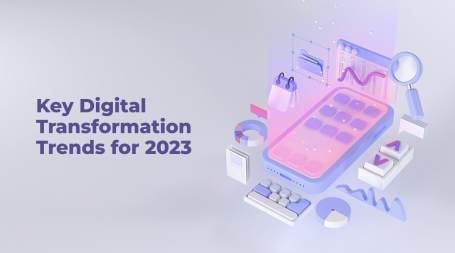Infrastructure is the backbone of a country, and infrastructure management is critical to ensure that the country can continue to thrive. But with increasingly limited budgets and stretched resources, it’s important for countries to explore new technologies that can improve efficiency and save money while still meeting the needs of citizens. This article will discuss one such technology: Internet of Things (IoT) in infrastructure management.
The Role of Digital Transformation in Infrastructure Management
The role of digital transformation in infrastructure management is a growing trend that has been adopted by organizations around the world. Digital transformation, or DT, refers to the process of using technology to transform an organization’s business model and operations for better customer experience, greater efficiency and productivity, enhanced financial performance, new revenue streams and other benefits.
The idea behind DT is simple: use digital tools such as IoT sensors and AI algorithms to automate routine tasks so that humans can focus on higher value activities like decision making or innovation. This allows companies not only to reduce costs but also improve their customer service levels by reducing wait times at airports (for instance).
In addition to improving efficiency through automation and freeing up resources for higher value tasks such as innovation; DT also enables organizations with real-time data insights into their infrastructure performance which helps them make better decisions about maintenance schedules before problems occur saving them time & money!
Leveraging IoT for Infrastructure Monitoring
IoT is simply a network of devices that are connected to each other and the internet. For example, if you have a smart thermostat in your home, this device will send data back to its manufacturer about its usage and performance. This information can then be used by engineers at the company who designed it to improve their products or develop new ones based on user feedback.
You might also have seen IoT being used for infrastructure monitoring purposes for example, sensors placed around an airport runway could track when planes take off, land and taxi around so that airlines can ensure they aren’t violating FAA regulations (e.g., flying too low).
Benefits of IoT in Infrastructure Management
The following are a few of the benefits of IoT in infrastructure management:
Improved asset management. IoT can help you track and manage assets, including their locations and usage patterns, which is essential for efficient infrastructure management services. This can lead to better decision making when it comes time for maintenance or replacement, which leads us to our next point.
Predictive maintenance. By using IoT sensors on equipment such as motors or pumps, you’ll be able to predict when components need replacement before they fail saving both money and downtime for your facility or business!
Remote monitoring & control. Sensors placed around critical areas allow you keep an eye on everything going on without having someone physically present 24/7 (or even during normal business hours).
Beyond IoT: Emerging Technologies in Infrastructure Management
In addition to Internet of Things (IoT) technologies, there are a number of emerging technologies that can be leveraged to improve infrastructure management. These include artificial intelligence (AI), blockchain, and cloud computing. While each has the potential to transform how you operate your business and deliver value to customers, they also present new challenges for IT departments that must adapt quickly if they want their organizations to stay competitive.
Data Analytics and Decision Support Systems
Data analytics is the process of collecting, storing, cleaning and analyzing data. Decision support systems are used to support decisions. Data analytics and decision support systems are important for infrastructure management because they help you make better decisions about your infrastructure.
Data analytics can be used in many different ways to improve the performance of your infrastructure. You can use it to collect information about how people use their facilities or equipment; this will allow you to identify potential problems before they become serious issues that require expensive repairs or replacements. You may also want to analyze past weather patterns so that you know what kinds of conditions will cause damage in certain areas at specific times of year (for example: snowfall during winter months could lead rainwater leaking through roofs). By analyzing this information ahead of time, management teams can take preventative measures such as installing new gutters before there’s any damage done!
Automation and AI in Infrastructure Maintenance
Infrastructure maintenance is a large part of the daily operations of a business. With so many moving parts, it’s important to have a good system in place to ensure that everything runs smoothly. While traditional methods like manual inspection and checklists can be helpful, they often don’t provide enough information about what’s happening with your infrastructure on an ongoing basis.
AI can help with predictive maintenance by analyzing data on past performance, equipment usage history and other factors to predict when something might go wrong before it does so you can take action before any damage occurs. For example: If there’s been an increase in temperature readings over time for one component on your server farm but nothing else has changed (e.g., new software updates), then this could indicate overheating issues that need immediate attention before they cause any damage or downtime later down the line when the problem gets worse – especially if there are no humans around 24/7 monitoring these things!
Challenges and Security Concerns
Security is a major concern when it comes to IoT, as the technology has many entry points for hackers. Because of this, it’s important that you have strong cybersecurity measures in place at all times. Privacy is another major issue that needs to be addressed; it’s vital that your customers know their data is safe and secure at all times. You should also consider what privacy policies are needed for each use case so everyone involved understands how their information will be used or shared.
Costs can quickly add up when implementing an IoT solution and not just because of hardware costs! You’ll need a team with technical knowledge who can help manage the backend infrastructure necessary for these systems as well as provide support when issues arise (which they inevitably will). If you’re looking into using cloud-based services like Amazon Web Services (AWS), Microsoft Azure or Google Cloud Platform (GCP), there may also be additional fees associated with those services depending on how much bandwidth/storage space is required by each device sending data back into them through APIs.
While there are many benefits to leveraging new technologies for improving infrastructure management, there are also challenges. The following sections highlight some of the main benefits and challenges of IoT and other emerging technologies that can be used to improve infrastructure management:
Benefits
The potential value of IoT is enormous, but it can only be realized if you have clear goals in mind before you start implementing your solution. As an example, if you want to increase safety on roads by using cameras with embedded sensors that detect traffic violations or accidents at night (a common problem), then you need a plan for analyzing data from these cameras so that they don’t end up just collecting dust on shelves somewhere after being installed.
Challenges
One challenge is figuring out how much time and money should go into each part of an IoT project especially when budgets are tight! Another challenge lies within managing all those devices once they’re deployed; this means ensuring they work together seamlessly while also keeping track of their maintenance needs over time.
Conclusion
We hope that this article has given you some insight into the potential of IoT in infrastructure management and how it could be used to improve your organization’s processes. We also know that there are many benefits to leveraging new technologies for improving infrastructure management, but there are challenges as well. That’s why it is important to consider all of these factors before making a decision about whether or not your company should adopt IoT devices within its network infrastructure.














